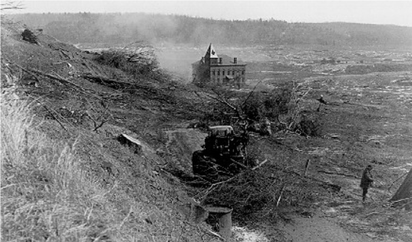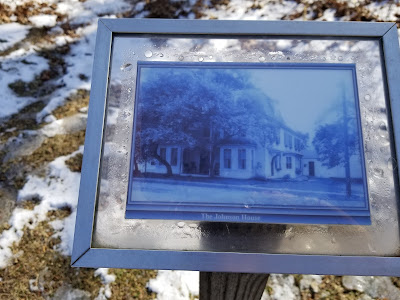There are three ways to hike here, and all are surprisingly difficult for a state like Connecticut. Easiest way is from the east, and that is what I'll write about here. You could also hike from the southwest over Brace Mountain or from the northwest near Alander Mountain, but each of those is a strenuous hike starting well under 1,000 feet. The eastern trailhead is just shy of 1,900 feet and, while you need to climb over Round Mountain and Frissell itself, it's a moderate hike.
The trailhead from the east is on East St in Mount Washington, Massachusetts. A small amount of parking is located near the state line, with room for a few cars on the east side of the road just north of a boundary marker.
 |
| CT/MA boundary marker along road |
Having left slightly later than I intended, I set out at 10:45 AM From there, I hiked west along the blue blazed and aptly-named "Mt. Frissell Trail". This trail generally runs along the state line, first heading northwest and ascending ever so slightly. After roughly 1/5 mile, there's a sharp turn to the south. Just after entering Connecticut for the first time, it turns west and the trail became steeper as I climbed Round Mountain, with a couple minor scrambles for good measure. Maybe 3/4 of a mile into the hike, the trail levels off at the bald summit of Round Mountain. Round Mountain, elevation 2,296 feet, is the second-highest summit inside Connecticut.
 |
| Cairn marking Round Mountain's summit |
 |
| View south from Round Mountain |
After taking a 20-30 minute break on a rock for water and an early lunch (it was already quite warm at 11:15 AM) while enjoying the view of the mountain I was about to climb, onward and downward I went. Steep at times, the trail descends into the col separating Round and Frissell and we eventually start to climb Frissell. Near the summit of Frissell lies a very short spur trail to the true summit, marked by a sign, cairn, and register, along with directions from here to the CT high point. Sign your name, head back to the main trail, and continue on (and DOWN) the remaining 300 yards to the high point, which is located at the right (north) side of the trail, approximately 1.5 miles into the hike.
 |
| A little anticlimactic, isn't it? |
Well, there we go. That little survey spike lies on the highest piece of land along the Connecticut/Massachusetts border. There's an ammo box here containing a register. While its main claim to fame is being the only state high point that isn't a summit, this place does have a nice view, even if it is only to the south. Much better view than the highest points of several states, actually.
 |
| Two looks south from Frissell |
 |
| The CT/MA/NY tripoint marker |

From here, many people continue on to Brace Mountain, highest point in Dutchess County, New York. Since I wanted to get to Rhode Island's high point before it closed for the day, I hightailed it back to my car and did Brace a few months later from the spectacular western approach (future post).
 |
| Saw this sign across from the trailhead on my way out |
While only 3.2 miles in length, this hike took me 2-2.5 hours, including breaks. Lots of rock scrambles to slow you down, plus I took plenty of time to enjoy the view and make sure I had water. A large amount of the difficulty here stems from the amount of rock scrambles and how exposed the trail is.
Getting Here
Connecticut might be a relatively-dense state, but its high point is in a pretty remote area. The trailhead is located on East St just north of the CT/MA state line at the southern edge of Mount Washington State Forest. No services are anywhere near the trailhead There are three main ways to get here:
- From MA Routes 23/41 to the north. This is the most direct access from points north and the Mass Pike/Interstate 90 and how I got to/from the trailhead. Roughly 2.5 miles is unpaved.
- From NY Routes 22/344 to the northwest. This route goes past Bash Bish Falls and merges with the above route near the trailhead. Doing this, you could easily add a stop at the falls. A minimum of 2.5 miles is unpaved (as above), more will be unpaved if you cut a corner and bypass Mount Washington Center.
- From US Route 44 in Salisbury. A minimum-maintenance road heads northwest from Salisbury and is the only way to reach the area of the CT high point through CT itself by car (though you cannot get to the high point without entering another state). Most of this route is unpaved and it does not get a ton of use. About 6 miles is unpaved.
Resources
Mount Washington State Forest: On the MA side of the border in this area




























































